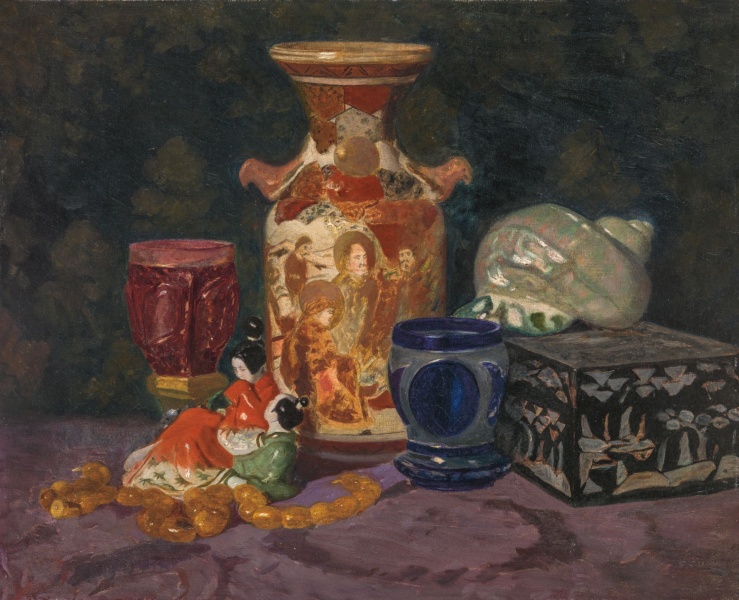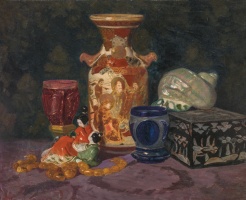
Oriental Still-Life with a Satsuma Vase and an Amber Necklace
| Author: | Lazar Krestin (1868–1938) |
Lazar Krestin (b. 1868 Kaunas – d. 1938 Vienna) was raised in a deeply religious family. His father, a Talmudic scholar, expected his son to become a rabbi, and sent him to a cheder and a yeshiva to receive a traditional religious education. He started drawing intensively at the age of 12, attended the Vilnius School of Drawing, and later studied in Vienna, Odessa and Munich. In 1910, invited by Boris Schatz, the founder of the Bezalel School of Arts and Crafts, he went to Jerusalem to work as a teacher. He and Schatz, both active Zionists, laid the foundations for Zionist art. Krestin later returned to Vienna. As a keen traveller, he would always bring home lots of sketches and drawings from his travels. He also visited Lithuania. Religious experience became his main source of inspiration: he was fond of depicting old Jews or children studying the Torah. He usually painted portraits from life: he would invite people who caught his eye to pose for him in his studio, or he sketched them on the street.
Source: Ellex Valiunas (LAWIN until 2015) art album: STORIES OF LITVAK ART (2023). Compiler and author Vilma Gradinskaitė.
Born in 1868 in Kaunas, died in 1939 in Vienna. Until 1890, he studied at the Vilnius Drawing School. In 1891, he was awarded a letter of commendation at a drawing competition of students of drawing schools held by the St. Petersburg Academy of Arts. From 1892, he studied painting in the Munich Academy of Fine Arts, and later switched to the Vienna Academy of Fine Arts. He remained to live in Vienna, where he won fame as a follower of Isidor Kaufmann, and painted genre scenes from the life of East European and Palestine Jews, trying to convey their traditional customs, clothing and denominational attributes. Krestin painted many portraits, and created a portrait gallery of outstanding Jews for the Vienna Jewish community. During a visit to Cracow, he painted some views of its environs. After a pogrom in Kishinev in 1903, he painted a programmatic composition ‘The Birth of the Jewish Resistance’. Dark colours and heavy brushstrokes characterize his painting. He was a member of the Vienna Artists’ Society.
Source: Académie de Vilna: Vilniaus piešimo mokykla 1866-1915 / Vilnius drawing school: Exhibition Catalogue, Nacionalinė dailės galerija 2017 m. 4 d. - lapkričio 26 d., compiled by Jolanta Širkaitė, Vilnius: Lietuvos kultūros tyrimų institutas, 2017, p. 236.

Lazar Krestin (b. 1868 Kaunas – d. 1938 Vienna) was raised in a deeply religious family. His father, a Talmudic scholar, expected his son to become a rabbi, and sent him to a cheder and a yeshiva to receive a traditional religious education. He started drawing intensively at the age of 12, attended the Vilnius School of Drawing, and later studied in Vienna, Odessa and Munich. In 1910, invited by Boris Schatz, the founder of the Bezalel School of Arts and Crafts, he went to Jerusalem to work as a teacher. He and Schatz, both active Zionists, laid the foundations for Zionist art. Krestin later returned to Vienna. As a keen traveller, he would always bring home lots of sketches and drawings from his travels. He also visited Lithuania. Religious experience became his main source of inspiration: he was fond of depicting old Jews or children studying the Torah. He usually painted portraits from life: he would invite people who caught his eye to pose for him in his studio, or he sketched them on the street.
Source: Ellex Valiunas (LAWIN until 2015) art album: STORIES OF LITVAK ART (2023). Compiler and author Vilma Gradinskaitė.
Born in 1868 in Kaunas, died in 1939 in Vienna. Until 1890, he studied at the Vilnius Drawing School. In 1891, he was awarded a letter of commendation at a drawing competition of students of drawing schools held by the St. Petersburg Academy of Arts. From 1892, he studied painting in the Munich Academy of Fine Arts, and later switched to the Vienna Academy of Fine Arts. He remained to live in Vienna, where he won fame as a follower of Isidor Kaufmann, and painted genre scenes from the life of East European and Palestine Jews, trying to convey their traditional customs, clothing and denominational attributes. Krestin painted many portraits, and created a portrait gallery of outstanding Jews for the Vienna Jewish community. During a visit to Cracow, he painted some views of its environs. After a pogrom in Kishinev in 1903, he painted a programmatic composition ‘The Birth of the Jewish Resistance’. Dark colours and heavy brushstrokes characterize his painting. He was a member of the Vienna Artists’ Society.
Source: Académie de Vilna: Vilniaus piešimo mokykla 1866-1915 / Vilnius drawing school: Exhibition Catalogue, Nacionalinė dailės galerija 2017 m. 4 d. - lapkričio 26 d., compiled by Jolanta Širkaitė, Vilnius: Lietuvos kultūros tyrimų institutas, 2017, p. 236.






